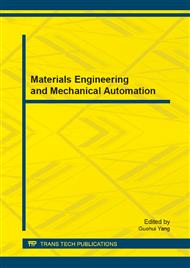p.64
p.73
p.78
p.83
p.88
p.94
p.98
p.104
p.110
Synthesis of Tetragonal BaTiO3 Powders via Alkoxide Method Assisted by Diethanolamine
Abstract:
The BaTiO3 precursor was prepared by alkoxide method, in which barium hydroxide octahydrate and butyl titanate were chosen as the Ba and Ti sources, and diethanolamine (DEA) as the polymerizing agent respectively. In order to determine the synthesis parameters of the target product, the phase transition process of the precursor with temperature increasing was investigated by TG-DTA. The effect of calcination temperature, the dosage of DEA and calcination time on the phase compositions and crystal structure of the synthesized samples were investigated by XRD. The results indicate that DEA can promote the formation of tetragonal BaTiO3 effectively, and the high-purity tetragonal BaTiO3 was obtained by heat treatment of the precursor at 1100°C for 3h with 1mL DEA dosage.
Info:
Periodical:
Pages:
88-93
Citation:
Online since:
October 2013
Authors:
Keywords:
Price:
Сopyright:
© 2014 Trans Tech Publications Ltd. All Rights Reserved
Share:
Citation:


